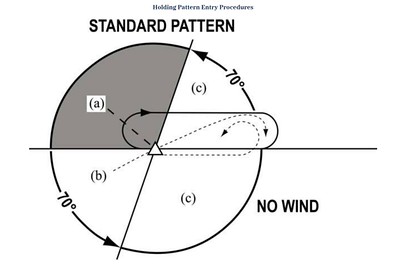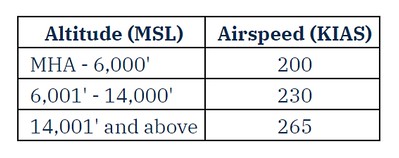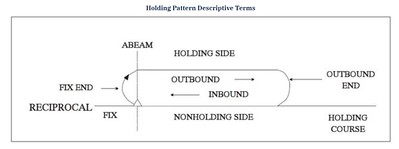Description
From the AIM regarding holding pattern entry procedures.
Entry Procedures. Holding protected airspace is designed based in part on pilot compliance with the three recommended holding pattern entry procedures discussed below. Deviations from these recommendations, coupled with excessive airspeed crossing the holding fix, may in some cases result in the aircraft exceeding holding protected airspace.
Parallel Procedure. When approaching the holding fix from anywhere in sector (a), the parallel entry procedure would be to turn to a heading to parallel the holding course outbound on the nonholding side for one minute, turn in the direction of the holding pattern through more than 180 degrees, and return to the holding fix or intercept the holding course inbound. (Harry's note - the AIM does not mention or state that the entry leg should be flown for a period longer than one minute if the holding pattern is 4 mile legs or something other than standard. So from reading the AIM, all entries are one minute legs.)
Teardrop Procedure. When approaching the holding fix from anywhere in sector (b), the teardrop entry procedure would be to fly to the fix, turn outbound to a heading for a 30 degree teardrop entry within the pattern (on the holding side) for a period of one minute, then turn in the direction of the holding pattern to intercept the inbound holding course. (Harry's note - the AIM does not mention or state that the entry leg should be flown for a period longer than one minute if the holding pattern is 4 mile legs or something other than standard. So from reading the AIM, all entries are one minute legs.)
Direct Entry Procedure. When approaching the holding fix from anywhere in sector (c), the direct entry procedure would be to fly directly to the fix and turn to follow the holding pattern.
While other entry procedures may enable the aircraft to enter the holding pattern and remain within protected airspace, the parallel, teardrop and direct entries are the procedures for entry and holding recommended by the FAA, and were derived as part of the development of the size and shape of the obstacle protection areas for holding.
Nonstandard Holding Pattern. Fix end and outbound end turns are made to the left. Entry procedures to a nonstandard pattern are oriented in relation to the 70 degree line on the holding side just as in the standard pattern.
Here's 4 simple steps to assist you in entering a holding pattern:
1. Go to the fix.
2. If, When leaving the fix, if the airplane is “outside” the hold then enter parallel. (Letter A below)
3. If, when leaving the fix, the plane is “inside” the holding pattern then enter teardrop. (Letter B below)
4. Everything else is a direct entry. (Letter C below)

From the AIM regarding holding instructions:
An ATC clearance requiring an aircraft to hold at a fix where the pattern is not charted will include the following information:
Direction of holding from the fix in terms of the eight cardinal compass points (i.e., N, NE, E, SE, etc.).
Holding fix (the fix may be omitted if included at the beginning of the transmission as the clearance limit).
Radial, course, bearing, airway or route on which the aircraft is to hold.
Leg length in miles if DME or RNAV is to be used (leg length will be specified in minutes on pilot request or if the controller considers it necessary).
Direction of turn if left turns are to be made, the pilot requests, or the controller considers it necessary.
Time to expect further clearance and any pertinent additional delay information.
Holding speeds

Holding pattern terms (click on the image for a larger view).

From the instrument rating ACS:
Knowledge - The applicant demonstrates understanding of:
IR.III.B.K1 - Elements related to holding procedures, including reporting criteria, appropriate speeds, and recommended entry procedures for standard, nonstandard, published, and nonpublished holding patterns.
Risk Management - The applicant demonstrates the ability to identify, assess and mitigate risks, encompassing:
IR.III.B.R1 Recalculating fuel reserves if assigned an unanticipated EFC time.
IR.III.B.R2 Scenarios and circumstances that could result in minimum fuel or the need to declare an emergency.
IR.III.B.R3 Scenarios that could lead to holding, including deteriorating weather at the planned destination.
IR.III.B.R4 Improper holding entry and improper wind correction while holding.
Skills - The applicant demonstrates the ability to:
IR.III.B.S1 Explain and use an entry procedure that ensures the airplane remains within the holding pattern airspace for a standard, nonstandard, published, or non-published holding pattern.
IR.III.B.S2 Change to the holding airspeed appropriate for the altitude or airplane when 3 minutes or less from, but prior to arriving at, the holding fix and set appropriate power as needed for fuel conservation.
IR.III.B.S3 Recognize arrival at the holding fix and promptly initiate entry into the holding pattern.
IR.III.B.S4 Maintain airspeed ±10 knots, altitude ±100 feet, selected headings within ±10°, and track a selected course, radial, or bearing within ¾-scale deflection of the CDI.
IR.III.B.S5 Use proper wind correction procedures to maintain the desired pattern and to arrive over the fix as close as possible to a specified time and maintain pattern leg lengths when specified.
IR.III.B.S6 Use an MFD and other graphical navigation displays, if installed, to monitor position in relation to the desired flightpath during holding.
IR.III.B.S7 Comply with ATC reporting requirements and restrictions associated with the holding pattern.
IR.III.B.S8 Demonstrate SRM.
IR.VI.C.R2 Holding, diverting, or electing to fly the approach again.
IR.VI.C.S10 Request ATC clearance to attempt another approach, proceed to the alternate airport, holding fix, or other clearance limit, as appropriate, or as directed by the evaluator.
instlp, cfiilp